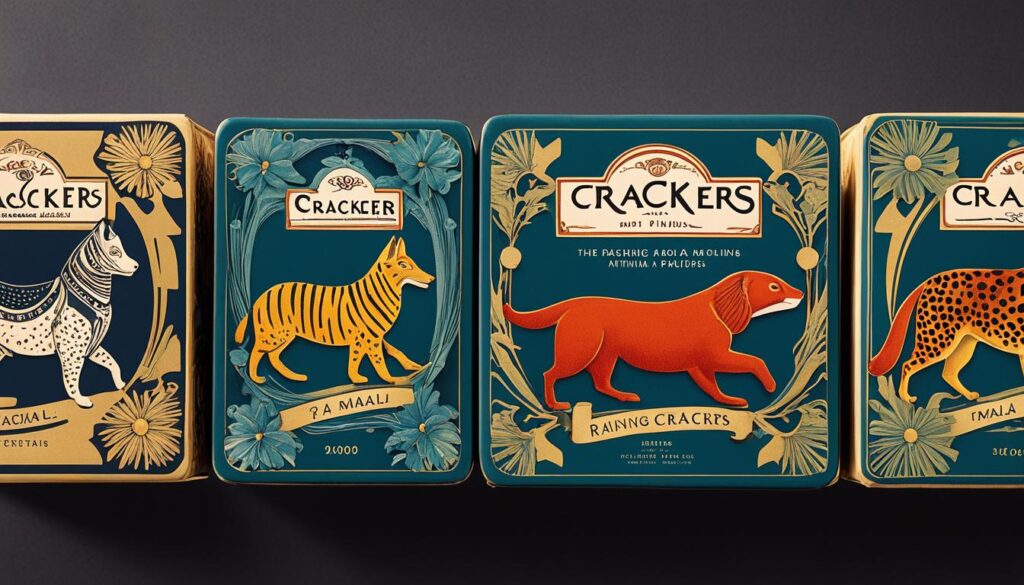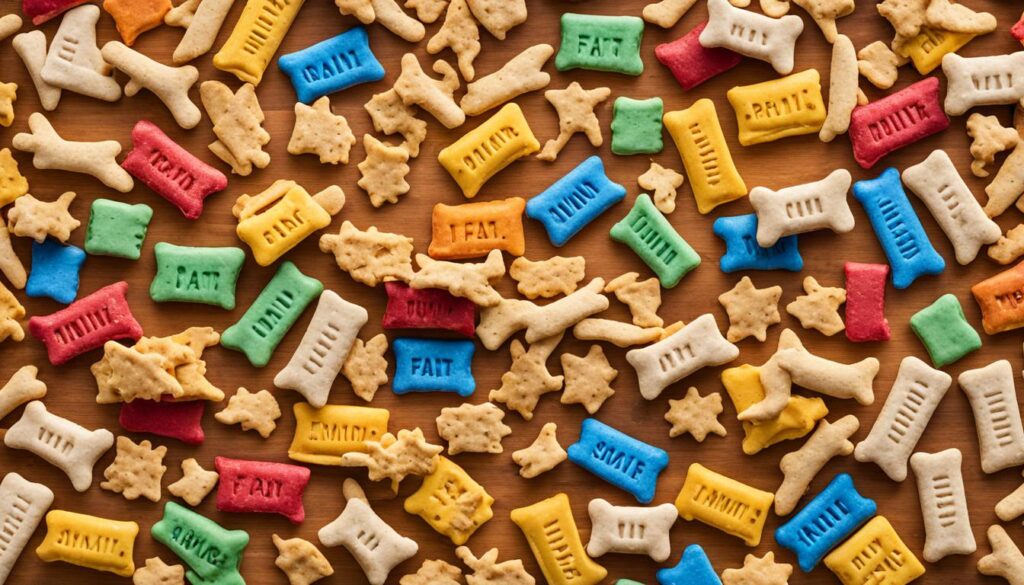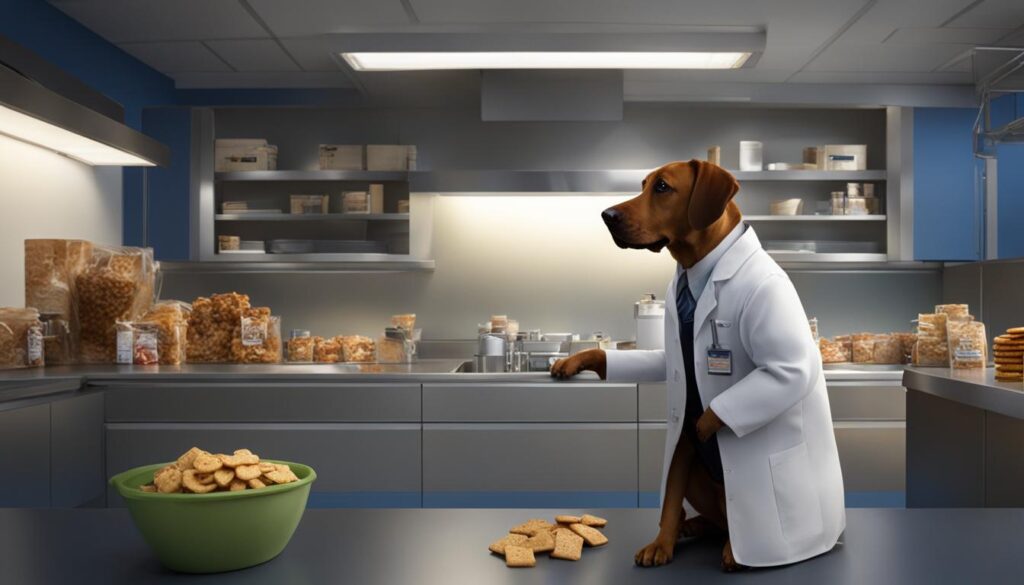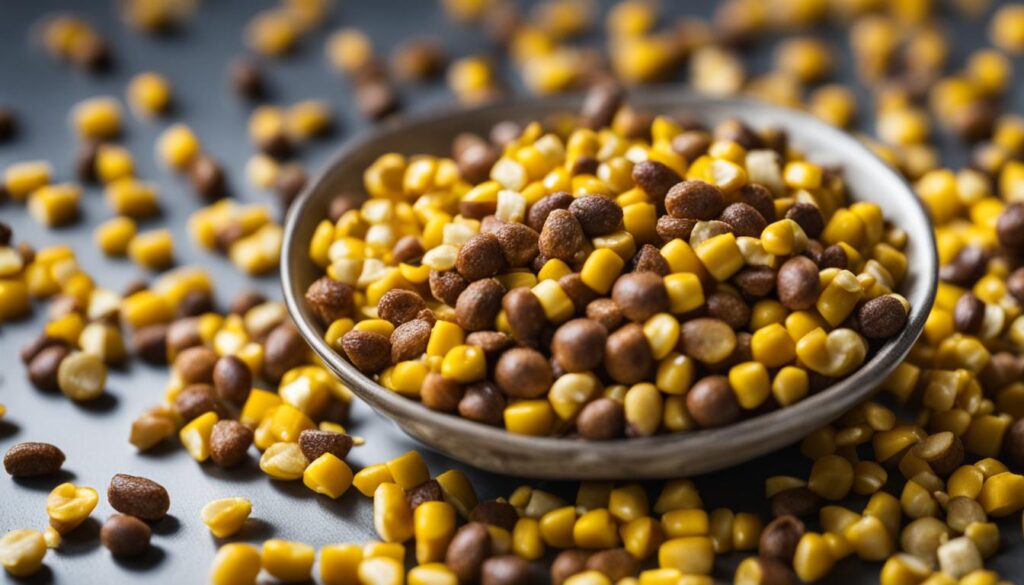Many dog owners wonder if it is safe to share their favorite snacks with their furry friends. One common question that arises is whether dogs can eat animal crackers. While animal crackers may seem harmless and even nostalgic, it’s important to consider the potential risks they pose to our canine companions.
Animal crackers are popular bite-sized, animal-shaped cookies enjoyed by children and adults. While they may not be toxic to dogs, they can pose potential health risks. Animal crackers often contain ingredients like sugar, artificial additives, and preservatives, which may not be suitable for dogs. Overconsumption of these treats can lead to weight gain and digestive issues.
Additionally, the shape and texture of animal crackers can pose a choking hazard, especially for smaller breeds or dogs prone to gulping their food. It is crucial to consult with veterinarians for expert advice on feeding animal crackers to dogs and to consider alternative treats that are recommended by professionals.
Key Takeaways:
- Animal crackers may not be toxic to dogs, but they can pose potential health risks due to ingredients like sugar and artificial additives.
- Overconsumption of animal crackers can lead to weight gain and digestive issues in dogs.
- The shape and texture of animal crackers can be a choking hazard, especially for smaller breeds or dogs prone to gulping their food.
- Consult with veterinarians for expert advice on feeding animal crackers to dogs and consider alternative treats recommended by professionals.
- Prioritize a balanced and nutritionally appropriate diet for dogs to ensure their optimal health and well-being.
Understanding the Basics: What are Animal Crackers?

Animal crackers are beloved flat biscuits that have been a staple in the snack world for decades. These bite-sized treats have captured the hearts (and taste buds) of both children and adults alike. But what exactly are animal crackers made of, and how did they become such a popular snack?
The history of animal crackers dates back to the late 19th century, when they were first introduced to the market. Originally, animal crackers were shaped like circus animals and were sold in a decorative box that resembled a circus wagon. Over the years, the taste and packaging of animal crackers have evolved, but their association with childhood nostalgia has remained.
The ingredients used to make animal crackers are relatively simple. They typically include flour, sugar, oil, and flavorings. These ingredients are mixed together to create a dough, which is then shaped into various animal shapes, such as lions, elephants, and bears. Once baked, the animal crackers become crispy and crunchy, making them a satisfying snack for many.
Animal crackers are often enjoyed on their own or with a glass of milk, making them a popular treat for many occasions. Whether packed in lunchboxes, enjoyed at parties, or savored during movie nights, animal crackers hold a special place in many people’s hearts.
In the next section, we will take a closer look at the nutritional content of animal crackers and the potential health hazards they may pose for dogs.
Nutritional Content of Animal Crackers

When considering the safety of feeding animal crackers to dogs, it is essential to examine the nutritional content and key ingredients in these popular treats. Animal crackers primarily consist of flour, sugar, vegetable oil, leavening agents, flavorings, and salt. While some of these ingredients may be safe for humans in moderation, they can pose potential health risks for dogs.
Dogs have different metabolic systems and dietary needs compared to humans. Excessive sugar consumption can lead to weight gain, dental issues, and even diabetes in dogs. The high salt content in animal crackers can cause electrolyte imbalances and potentially contribute to kidney issues in our furry friends. Additionally, some dogs may have sensitivities or allergies to specific ingredients like wheat flour.
It is crucial for dog owners to be aware of these factors and consider the potential risks before feeding animal crackers to their pets. Consulting with a veterinarian can provide valuable guidance on whether animal crackers are suitable for your dog’s diet and help identify healthier treat options.
Possible Health Risks of Feeding Animal Crackers to Dogs

Feeding animal crackers to dogs can pose several potential health risks. It’s important to be aware of these risks and consider the well-being of your furry friend before sharing these treats with them.
- Overconsumption Risks: Animal crackers are typically high in sugar and carbohydrates, which can lead to weight gain in dogs if consumed in excess. Overindulging in these treats can also result in digestive issues, such as upset stomach, diarrhea, or vomiting.
- Allergic Reactions: Some dogs may have allergies or sensitivities to certain ingredients found in animal crackers. These allergies can manifest as gastrointestinal upset, itching, or skin rashes. It’s essential to monitor your dog for any adverse reactions after consuming these treats.
- Choking Hazard: The shape and texture of animal crackers can pose a choking hazard for dogs, especially for small breeds or dogs prone to gulping their food. It’s crucial to supervise your dog while they enjoy these treats to prevent any potential choking incidents.
- Long-Term Health Risks: Regular consumption of animal crackers can contribute to long-term health issues in dogs. The high sugar content can lead to dental problems, such as tooth decay, gum disease, or tartar buildup. Additionally, the excess sugar intake can increase the risk of developing diabetes or obesity over time.
Considering these risks, it’s advisable to consult with your veterinarian before introducing animal crackers into your dog’s diet. They can provide personalized guidance based on your dog’s specific needs and dietary requirements. Alternatives to animal crackers, such as dog-friendly treats formulated with wholesome ingredients, may be a safer option for your furry companion.
Image: Choking Hazard – Animal Cracker Shape and Texture
| Risks | Effects |
|---|---|
| Overconsumption | Weight gain, digestive issues |
| Allergic Reactions | Gastrointestinal upset, itching, skin rashes |
| Choking Hazard | Potential choking incidents for small breeds or dogs prone to gulping food |
| Long-Term Health Risks | Dental problems, diabetes, obesity |
Veterinarian’s Take on Dogs Eating Animal Crackers

Veterinarians play a crucial role in guiding dog owners on nutrition and dietary choices. When it comes to feeding animal crackers to dogs, veterinarians generally advise caution and recommend prioritizing a balanced and nutritionally appropriate diet for our beloved canines.
While small quantities of animal crackers on occasion may not pose significant health risks, it is essential to consider a dog’s specific needs and dietary requirements. Veterinarians can provide valuable insights tailored to individual dogs, ensuring their overall well-being.
When determining whether it is safe to give your dog animal crackers, veterinarians consider factors such as a dog’s age, weight, and any existing medical conditions. They can guide owners on when and how to safely introduce animal crackers into a dog’s diet, advise on suitable portion sizes, and recommend alternative treats that are specifically designed for dogs.
Remember that dogs have different metabolic systems and dietary needs compared to humans. What may be harmless for us might not be suitable for our furry friends. It is crucial to consult with veterinarians for expert opinions and to make informed decisions regarding our dogs’ diets.
“Consulting with a veterinarian is essential when considering adding animal crackers to a dog’s diet. They can provide guidance tailored to the individual dog’s specific needs and help ensure a balanced and nutritionally appropriate diet”
The Right Protein is Key
Dogs require good, digestible protein in their diets to support their overall health and well-being. Animal-based protein sources, such as muscle meat, are more easily digested by dogs compared to other parts of animals. It is important to choose dog food that contains high-quality, real meat as the primary source of protein. This protein should be listed within the first five ingredients on the food label. Rotating protein sources in a dog’s diet can help prevent allergies and keep them excited about their food.
Benefits of Good Digestible Protein for Dogs
- Supports muscle development and repair
- Aids in maintaining healthy skin and coat
- Helps support a strong immune system
- Contributes to optimal organ function
“Good digestible protein is essential for dogs as it provides them with the necessary amino acids to support their overall health and well-being.” – Dr. Sarah Smith, Veterinarian
When choosing a dog food, look for high-quality protein sources like chicken, beef, lamb, and fish. These animal proteins supply the necessary amino acids that dogs require for proper growth and development. Ideally, the protein should be listed as the first ingredient on the food label, indicating that it is the primary source of protein in the formula.
Rotating protein sources in a dog’s diet is also beneficial. This helps prevent allergies from developing due to prolonged exposure to a single protein source. It also keeps dogs excited about their meals, preventing them from getting bored with their food.
Rotate Your Dog’s Food

Contrary to common belief, dogs do not need to be kept on the same type of food indefinitely. In fact, rotating protein sources in a dog’s diet can have several benefits.
- Keeps dogs excited about their food.
- Reduces the risk of developing allergies from prolonged exposure to one protein source.
- Allows for a balanced and varied diet.
Rotating your dog’s food can ensure they receive a wide range of nutrients and flavors. Many high-quality dog foods are formulated to be easily switched out without causing digestive upset.
Consulting with a veterinarian is important when considering a food rotation strategy. They can provide guidance on the different protein sources suitable for your dog’s specific dietary needs. Gradually introducing new foods and monitoring your dog’s response can help ensure a smooth transition and avoid any digestive issues.
By regularly changing your dog’s food, you can provide them with a more complete and diverse nutritional profile, supporting their overall health and well-being.
| Benefits of Rotating Dog Food | Avoiding Allergies |
|---|---|
| Keeps dogs excited about their food | Reduces the risk of developing allergies from prolonged exposure to one protein source |
| Provides a balanced and varied diet | Allows for a wide range of nutrients and flavors |
| Supports overall health and well-being | Provides a more complete and diverse nutritional profile |
The Dangers of Corn and By-Products in Dog Food

Corn and by-products are common ingredients found in lower quality dog foods. While they may seem like cost-effective options for manufacturers, they can have detrimental effects on a dog’s health. Corn, for example, is often used as a filler ingredient that provides little nutritional value to dogs. It can contribute to weight gain, diabetes, and digestive issues. By-products, such as animal parts like hair, horns, and beaks, are often used as fillers and have limited nutritional benefits for dogs.
Choosing the right dog food is crucial for ensuring optimal nutrition and well-being for our furry friends. Avoiding dog food that contains corn and by-products and instead focusing on high-quality protein sources is essential. Dogs require a balanced diet that includes quality protein, carbohydrates, and fats, as well as essential vitamins and minerals.
Why Corn is a Problem in Dog Food
Corn is a cheap and easily accessible ingredient that is used as a filler in many lower quality dog foods. While it may provide energy, it lacks the necessary nutrients that dogs need for proper growth, development, and overall health. Some potential issues associated with corn in dog food include:
- Poor digestibility: Dogs have difficulty digesting corn, which can lead to digestive problems such as gas, bloating, and diarrhea.
- Allergies and sensitivities: Corn is a common allergen for dogs and can cause allergic reactions such as itching, skin rashes, and gastrointestinal upset.
Concerns with By-Products in Dog Food
By-products are often used as inexpensive sources of protein in dog food. Unfortunately, these animal parts offer limited nutritional benefits and can even pose health risks for dogs. Here are some concerns associated with by-products in dog food:
- Low-quality protein: By-products may contain low-quality protein sources, which are less digestible and provide fewer essential amino acids for dogs.
- Potential contamination: By-products can include animal parts that are unfit for human consumption, such as hair, beaks, and feathers, which can be contaminated with bacteria or other harmful substances.
- Limited nutritional value: By-products lack the valuable nutrients found in high-quality muscle meat, resulting in an incomplete and imbalanced diet for dogs.
When choosing dog food, it’s important to read the ingredient list carefully and opt for high-quality products that prioritize real, whole ingredients. Look for dog foods that list specific animal protein sources, such as chicken, beef, or lamb, as the main ingredient. Avoiding corn and by-products can significantly improve a dog’s overall nutrition and health.
Healthier Alternatives to Animal Crackers
When it comes to treating our dogs, it’s important to choose options that prioritize their health and well-being. Instead of feeding them animal crackers, which may contain ingredients that are not suitable for dogs, there are healthier alternatives available. These alternatives include dog biscuits and cookies that are specifically formulated to meet a dog’s nutritional needs, providing them with a tasty and safe snack option.
Furthermore, homemade dog crackers can be a great alternative to store-bought treats. By using quality ingredients and carefully following a recipe, you can ensure that your homemade dog crackers are both delicious and nutritious for your furry friend. Making your own treats allows you to have control over the ingredients, avoiding potential health risks associated with commercially produced options.
When considering alternative treats for your dog, it is important to consult with veterinarians. They can provide guidance on suitable options based on your dog’s specific dietary needs and any potential health concerns. Veterinarians may recommend specific brands or recipes that are known to be healthy and safe for dogs.
By choosing healthier alternatives to animal crackers, you can provide your dog with treats that not only taste good but also contribute to their overall health and well-being. Remember to prioritize their dietary needs and consult with professionals to ensure that you are making the best choices for your beloved companion.
Wrapping Up
While animal crackers may not be toxic to dogs, it is important to be aware of the potential health risks they pose. These snacks often contain ingredients like sugar, salt, and artificial additives, which may not be suitable for dogs. Overconsumption of animal crackers can lead to weight gain, digestive issues, and other long-term health problems in our canine companions.
When it comes to feeding animal crackers to dogs, moderation is key. Consulting with veterinarians is imperative to receive expert advice tailored to your dog’s specific needs and dietary requirements. Veterinarians can guide you on whether it is safe to include animal crackers in your dog’s diet, advise on portion sizes, and recommend alternative treats that prioritize the health and well-being of your furry friend.
Fortunately, there are many healthier alternatives and dog-friendly treat options available. Dog biscuits and cookies formulated with a dog’s nutritional needs in mind can provide a tasty and safe snack alternative. If you prefer homemade options, you can even make your own dog crackers using high-quality, dog-safe ingredients. These alternatives ensure that your dog receives optimal nutrition and minimizes potential health risks associated with animal crackers.
FAQ
Can dogs eat animal crackers?
While animal crackers may not be toxic to dogs, they can pose potential health risks. They often contain ingredients like sugar, salt, and artificial additives, which may not be suitable for dogs. It is important to consult with veterinarians for expert advice on feeding animal crackers to dogs and to consider alternative treats that are recommended by professionals.
What are animal crackers?
Animal crackers are flat biscuits made from a combination of ingredients like flour, sugar, oil, and flavorings. They were first introduced in the late 19th century and have evolved in taste and packaging over the years. Animal crackers are often associated with childhood nostalgia and are popular among kids.
What is the nutritional content of animal crackers?
Animal crackers primarily consist of flour, sugar, vegetable oil, leavening agents, flavorings, and salt. While some of these ingredients may be safe for humans in moderation, they can pose potential health risks for dogs. Dogs have different metabolic systems and dietary needs compared to humans. It is important to consider these factors before feeding animal crackers to dogs.
What are the possible health risks of feeding animal crackers to dogs?
Feeding animal crackers to dogs can pose several potential health risks. Overconsumption of these treats can lead to weight gain, digestive issues, and other obesity-related health problems. Some dogs may have allergies or sensitivities to certain ingredients found in animal crackers, which can manifest as gastrointestinal upset, itching, or skin rashes. The shape and texture of animal crackers can potentially cause choking, especially for small breeds or dogs prone to gulping their food.
What do veterinarians say about dogs eating animal crackers?
Veterinarians generally advise caution when it comes to feeding animal crackers to dogs. While small quantities on occasion may not pose significant health risks, it is important to prioritize a balanced and nutritionally appropriate diet for dogs. Veterinarians can provide valuable insights tailored to a dog’s specific needs and dietary requirements.
Why is the right protein important for dogs?
Dogs require good, digestible protein in their diets to support their overall health and well-being. Animal-based protein sources, such as muscle meat, are more easily digested by dogs compared to other parts of animals. It is important to choose dog food that contains high-quality, real meat as the primary source of protein.
Should I rotate my dog’s food?
Contrary to common belief, dogs do not need to be kept on the same type of food indefinitely. In fact, rotating protein sources in a dog’s diet can have several benefits. It keeps dogs excited about their food and reduces the risk of developing allergies from prolonged exposure to one protein source.
What are the dangers of corn and by-products in dog food?
Corn and by-products are common ingredients found in lower quality dog foods. Corn is a cheap filler ingredient that provides little nutritional value to dogs and can contribute to weight gain, diabetes, and digestive issues. By-products, such as animal parts like hair, horns, and beaks, are often used as fillers and have limited nutritional benefits for dogs.
What are healthier alternatives to animal crackers for dogs?
Instead of feeding animal crackers to dogs, there are healthier alternatives available. Dog biscuits and cookies formulated with a dog’s nutritional needs in mind can provide a tasty and safe snack option. Homemade dog crackers can also be made using quality ingredients to ensure optimal nutrition and avoid potential health risks.
Can dogs eat animal crackers? (Wrapping Up)
While animal crackers may not be toxic to dogs, they can pose potential health risks and should be fed in moderation. It is important to consult with veterinarians and consider alternative treats that are recommended for dogs.






